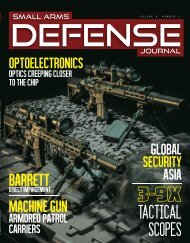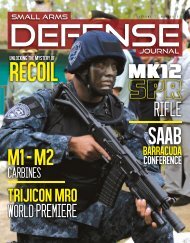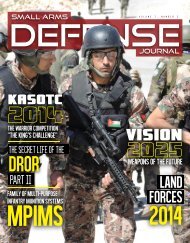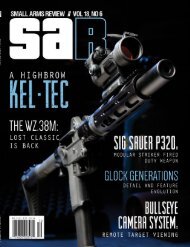SAR 20#2
Create successful ePaper yourself
Turn your PDF publications into a flip-book with our unique Google optimized e-Paper software.
THE AMT<br />
AUTOMAG III<br />
BY FRANK IANNAMICO<br />
ABOVE: A vintage M1 carbine is displayed with an Automag III pistols and a box of 1944 dated Winchester carbine ammo. The loose<br />
rounds in the photo are modern soft-points.<br />
Probably the best promotional advertising<br />
for any firearm is to be featured in<br />
a Hollywood film. An example was when<br />
the Smith & Wesson Model 29 appeared<br />
in several of the Dirty Harry movies beginning<br />
in 1971. The demand, and asking<br />
price, for S&Ws .44 Magnum revolvers<br />
skyrocketed and they soon became<br />
very difficult to find.<br />
The term Auto Mag became part of<br />
the American lexicon in a 1983 sequel<br />
to the Dirty Harry film, Sudden Impact.<br />
In that film Clint Eastwood’s character<br />
inspector Harry Callahan, uses his .44<br />
Auto Mag pistol to take down the bad<br />
guys. In the 1987 film Beverly Hills Cop<br />
II a .44 Auto Mag is used by the bad<br />
guys. However, due in part to a lack<br />
of availability, sales of the Auto Mag<br />
pistol never approached that of Dirty<br />
Harry’s Model 29.<br />
THE AUTO MAG PISTOL<br />
The original Auto Mag pistol was<br />
conceived and designed by Harry<br />
Sanford and Max Gera during the late<br />
1960s. Mr. Sanford established the Auto<br />
Mag Corporation during 1969 in Cali-<br />
fornia. The .44 AMP (Auto Mag Pistol)<br />
cartridge was also conceived by Harry<br />
Sanford. The original cartridge cases<br />
were formed from .308 rifle brass shortened<br />
to a length of 1.298 inches. The<br />
bullet was .429-caliber 240-grain with a<br />
powder charge of 26 grains. The average<br />
velocity was 1450 feet per second<br />
with 1120-ft/lbs of energy.<br />
Production of the Auto Mag pistol<br />
began at a factory located in Pasadena,<br />
California during 1970. The first gun<br />
was shipped to a dealer in August 1971.<br />
After producing only a few thousand<br />
pistols, the Auto Mag Corporation declared<br />
bankruptcy on May 3, 1972. The<br />
Trust Deeds Estates Corporation (TDE)<br />
of El Monte, California purchased the<br />
machinery, unfinished guns and parts.<br />
They also hired Sanford to produce the<br />
guns from the parts. In 1974 after new<br />
financing was acquired, TDE made minor<br />
engineering changes and re-tooled<br />
for complete production. In September<br />
of that year Lee Jurras signed an exclusive<br />
world-wide sales and distribution<br />
agreement for all Auto Mag pistols. Mr.<br />
Jurras not only took over distribution but<br />
also handled warranty and parts supply.<br />
By 1982 the Auto Mag was once<br />
again facing financial difficulties, the assets<br />
changing hands and logos several<br />
times before the Auto Mag pistol passed<br />
into history. In the end there were Auto<br />
Mag pistols produced with Pasadena,<br />
North Hollywood and El Monte, California<br />
addresses.<br />
THE AUTOMAG II<br />
Automag Pistols<br />
During 1987, the .22 magnum Automag<br />
II pistol was introduced, the<br />
Automag name now appearing as one<br />
word. The new pistol was designed by<br />
Harry Grossman and manufactured by<br />
Arcadia Machine and Tool Inc. / AMT of<br />
Covina, California; a company owned<br />
by the same Harry Sanford of the original<br />
Auto Mag Corporation. After the<br />
original AMT encountered financial<br />
problems a new company was formed<br />
in 1989 called Irwindale Arms Inc or<br />
IAI, relocated to Irwindale, California.<br />
At the 1989 SHOT show it was announced<br />
that IAI would be producing the<br />
Automag II and III.<br />
<strong>SAR</strong> Vol. 20, No. 2 62 MARCH 2016









